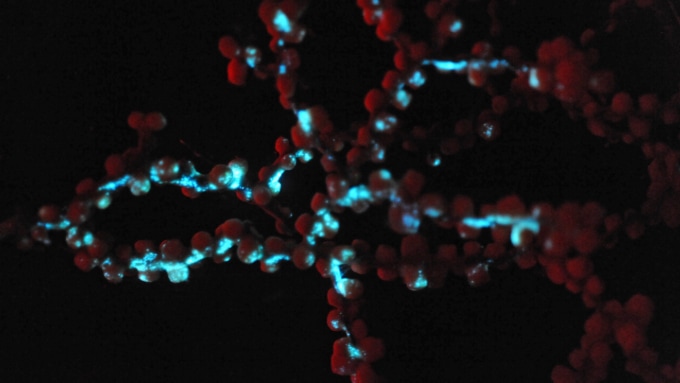algae: Single-celled organisms, once considered plants (they aren’t). As aquatic organisms, they grow in water. Like green plants, they depend on sunlight to make their food.
ancestor: A predecessor. It could be a family forebear, such as a parent, grandparent or great-great-great grandparent. Or it could be a species, genus, family or other order of organisms from which some later one evolved. For instance, ancient dinosaurs are the ancestors of today's birds. (antonym: descendant)
bacteria: (singular: bacterium) Single-celled organisms. These dwell nearly everywhere on Earth, from the bottom of the sea to inside other living organisms (such as plants and animals). Bacteria are one of the three domains of life on Earth.
biologist: A scientist involved in the study of living things.
bioluminescent: (n. bioluminescence) An adjective that describes the light emitted by certain animals — such as fireflies, squid and deep-sea fishes — and by some shallow-water algae.
chemical: A substance formed from two or more atoms that unite (bond) in a fixed proportion and structure. For example, water is a chemical made when two hydrogen atoms bond to one oxygen atom. Its chemical formula is H2O. Chemical also can be an adjective to describe properties of materials that are the result of various reactions between different compounds.
chemical reaction: A process that involves the rearrangement of the molecules or structure of a substance, as opposed to a change in physical form (as from a solid to a gas).
colleague: Someone who works with another; a co-worker or team member.
coral: Marine animals that often produce a hard and stony exoskeleton and tend to live on reefs (the exoskeletons of dead ancestor corals).
DNA: (short for deoxyribonucleic acid) A long, double-stranded and spiral-shaped molecule inside most living cells that carries genetic instructions. It is built on a backbone of phosphorus, oxygen, and carbon atoms. In all living things, from plants and animals to microbes, these instructions tell cells which molecules to make.
evolution: (v. to evolve) A process by which species undergo changes over time, usually through genetic variation and natural selection. These changes usually result in a new type of organism better suited for its environment than the earlier type. The newer type is not necessarily more “advanced,” just better adapted to the particular conditions in which it developed. Or the term can refer to changes that occur as some natural progression within the non-living world (such as computer chips evolving to smaller devices which operate at an ever faster speed).
evolutionary biologist: Someone who studies the adaptive processes that have led to the diversity of life on Earth. These scientists can study many different subjects, including the microbiology and genetics of living organisms, how species change to adapt, and the fossil record (to assess how various ancient species are related to each other and to modern-day relatives).
fossil: Any preserved remains or traces of ancient life. There are many different types of fossils: The bones and other body parts of dinosaurs are called “body fossils.” Things like footprints are called “trace fossils.” Even specimens of dinosaur poop are fossils. The process of forming fossils is called fossilization.
genetic: Having to do with chromosomes, DNA and the genes contained within DNA. The field of science dealing with these biological instructions is known as genetics. People who work in this field are geneticists.
jellies: (in biology) These are gelatinous animals that drift in water (mostly seawater) or brackish (semi-salty) estuaries. For more than 500 million years, they have moved around the oceans by pumping pulses of water through their jelly-like tissue. Their body often has an umbrella-shaped bell. Trailing from around a central mouth may be many tentacles. Although jellies don’t have brains, they do have a nervous system which can sometimes detect light, movement or certain chemicals. Some members of this family, known as cnidarians, are known as jellyfish. In fact, none are true fish but related to hydras and corals.
organism: Any living thing, from elephants and plants to bacteria and other types of single-celled life.
prey: (n.) Animal species eaten by others. (v.) To attack and eat another species.
probability: A mathematical calculation or assessment (essentially the chance) of how likely something is to occur.
sea: An ocean (or region that is part of an ocean). Unlike lakes and streams, seawater — or ocean water — is salty.
species: A group of similar organisms capable of producing offspring that can survive and reproduce.
trait: A characteristic feature of something. (in genetics) A quality or characteristic that can be inherited.
tree of life: A diagram that uses a branched, treelike structure to show how organisms relate to one another. Outer, twiglike, branches represent species alive today. Ancestors of today’s species will lie on thicker limbs, ones closer to the trunk.









